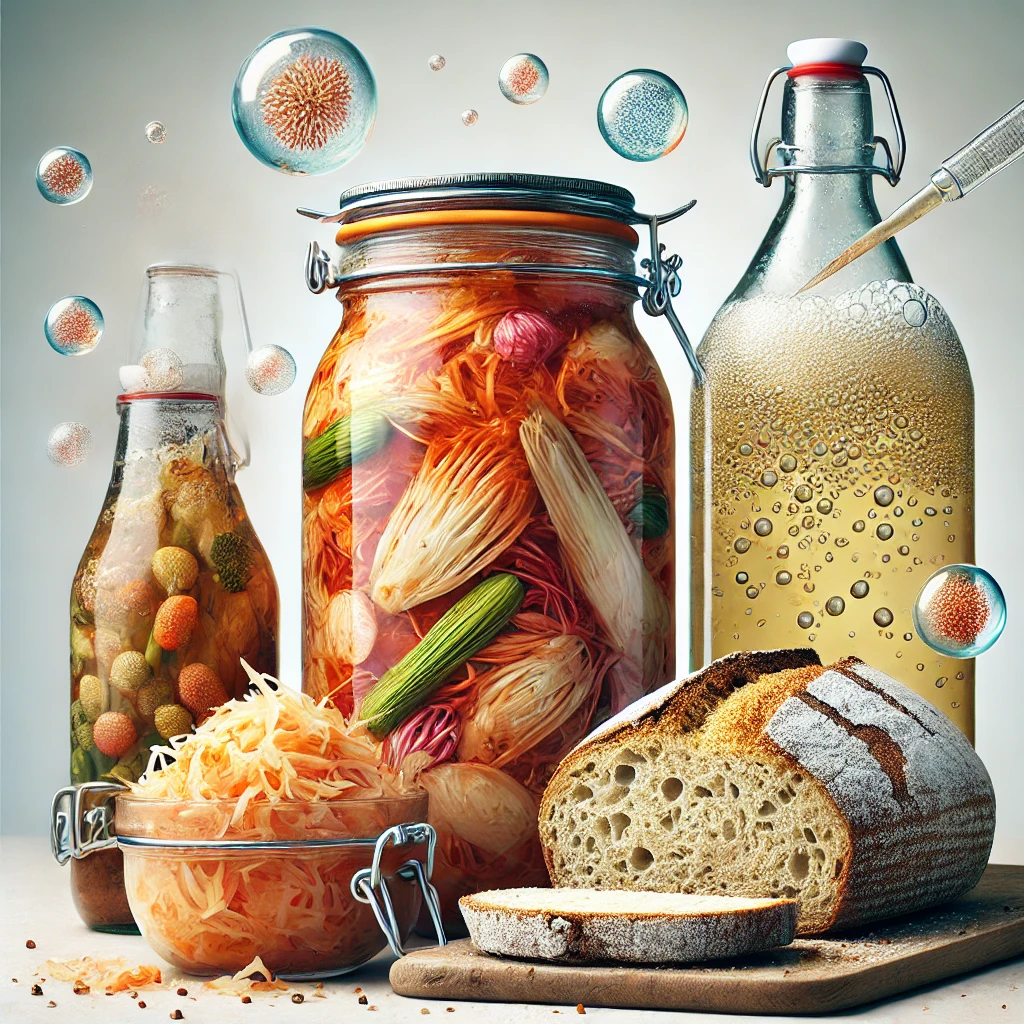Fermentation is a fascinating process that has been used for thousands of years to transform ordinary ingredients into extraordinary foods and beverages. From the tangy taste of yogurt to the effervescence of kombucha, fermented foods have a unique flavor and a host of health benefits. But what exactly is fermentation, and how does it work? In this article, we’ll delve into the science behind fermentation, exploring how microbes like bacteria, yeast, and mold play a crucial role in transforming food, and why fermentation is so important in culinary traditions around the world.
What is Fermentation?
Definition and History: Fermentation is a metabolic process that converts sugars into acids, gases, or alcohol. This process is carried out by microorganisms such as bacteria, yeast, and mold, which consume the sugars and produce byproducts like lactic acid, carbon dioxide, or ethanol. Fermentation has been used for millennia to preserve food, enhance flavors, and create beverages like beer, wine, and spirits.
The history of fermentation dates back to ancient civilizations. The earliest evidence of fermented beverages comes from China around 7000 BCE, where a type of fermented rice drink was produced. In ancient Egypt, beer and bread were staples of the diet, both made possible by fermentation. Fermented dairy products like yogurt and kefir have been consumed for thousands of years in the Middle East and Central Asia. Today, fermentation continues to be a vital part of global cuisine, from fermented vegetables in Korea to sourdough bread in Europe.
The Role of Microbes: Microorganisms are the unsung heroes of fermentation. These tiny organisms, which include bacteria, yeast, and mold, play a crucial role in the fermentation process. Each type of microbe has a specific function:
- Bacteria: Certain types of bacteria, such as Lactobacillus and Bifidobacterium, are responsible for lactic acid fermentation. They convert sugars into lactic acid, which acts as a preservative and gives fermented foods like yogurt, sauerkraut, and kimchi their tangy flavor.
- Yeast: Yeast, particularly Saccharomyces cerevisiae, is responsible for alcoholic fermentation. It converts sugars into alcohol and carbon dioxide, which is essential in the production of beer, wine, and bread.
- Mold: Molds like Aspergillus oryzae are used in the fermentation of certain foods, such as soy sauce and miso. They break down complex carbohydrates and proteins into simpler compounds, enhancing flavor and digestibility.
Types of Fermentation: There are several types of fermentation, each resulting in different products and flavors. The most common types include:
- Lactic Acid Fermentation: This type of fermentation is carried out by lactic acid bacteria and is used to produce foods like yogurt, sauerkraut, kimchi, and sourdough bread. Lactic acid fermentation is also responsible for the tangy flavor and preservation of these foods.
- Alcoholic Fermentation: Yeast is the primary microorganism involved in alcoholic fermentation, where it converts sugars into ethanol and carbon dioxide. This type of fermentation is used to produce alcoholic beverages like beer, wine, and spirits, as well as bread.
- Acetic Acid Fermentation: Acetic acid bacteria, such as Acetobacter, are involved in acetic acid fermentation, where ethanol is converted into acetic acid. This process is used to produce vinegar and certain types of kombucha.
- Koji Fermentation: Koji is a type of mold, specifically Aspergillus oryzae, that is used in the fermentation of foods like soy sauce, miso, and sake. The mold breaks down starches and proteins into simpler compounds, enhancing the flavor and texture of the food.
The Science of Fermentation
Biochemical Process: The biochemical process of fermentation involves the breakdown of sugars into simpler compounds by microorganisms. Here’s a closer look at the process:
- Glycolysis: Fermentation begins with glycolysis, a series of reactions that break down glucose (a type of sugar) into pyruvate. This process occurs in the cytoplasm of the cell and produces a small amount of energy in the form of ATP (adenosine triphosphate).
- Fermentation Pathways: Depending on the type of microorganism and the environmental conditions, pyruvate can be further processed through different fermentation pathways:
- Lactic Acid Fermentation: In lactic acid fermentation, pyruvate is converted into lactic acid by lactic acid bacteria. This process regenerates NAD+ (nicotinamide adenine dinucleotide), which is essential for glycolysis to continue.
- Alcoholic Fermentation: In alcoholic fermentation, pyruvate is converted into ethanol and carbon dioxide by yeast. This process also regenerates NAD+ and produces alcohol as a byproduct.
- Acetic Acid Fermentation: In acetic acid fermentation, ethanol is oxidized into acetic acid by acetic acid bacteria. This process requires oxygen and produces vinegar.
Health Benefits: Fermented foods offer a range of health benefits, thanks to the presence of beneficial microbes, vitamins, and bioactive compounds. Some of the key health benefits include:
- Improved Digestion: Fermented foods are rich in probiotics, which are beneficial bacteria that support gut health. Probiotics help maintain a healthy balance of gut flora, improve digestion, and reduce symptoms of digestive disorders like irritable bowel syndrome (IBS).
- Enhanced Nutrient Absorption: Fermentation can increase the bioavailability of certain nutrients, making them easier for the body to absorb. For example, the fermentation of soybeans into tempeh or miso increases the availability of protein, vitamins, and minerals.
- Immune Support: The probiotics in fermented foods can boost the immune system by enhancing the function of the gut-associated lymphoid tissue (GALT), which plays a key role in immune response. A healthy gut microbiome also helps protect against harmful pathogens.
- Antioxidant Properties: Fermented foods often contain higher levels of antioxidants, which help protect cells from oxidative stress and reduce the risk of chronic diseases like heart disease and cancer.
Flavor Development: Fermentation not only preserves food but also enhances its flavor. The transformation of sugars into acids, alcohol, and other compounds during fermentation creates a complex and layered flavor profile that is unique to each fermented food. Here’s how fermentation affects flavor:
- Tanginess: The production of lactic acid during fermentation gives foods like yogurt, sauerkraut, and sourdough bread their characteristic tangy flavor.
- Umami: Fermentation can enhance the umami flavor, which is often described as savory or meaty. Foods like miso, soy sauce, and aged cheeses have a strong umami flavor due to the breakdown of proteins into amino acids like glutamate.
- Sweetness: Alcoholic fermentation can enhance the natural sweetness of foods and beverages. For example, the fermentation of grapes into wine concentrates the sugars, resulting in a sweeter taste.
- Complexity: The combination of different fermentation byproducts, such as acids, alcohols, and esters, creates a complex and multi-dimensional flavor profile that is unique to each fermented food.
Popular Fermented Foods Around the World
Kimchi (Korea): Kimchi is a traditional Korean dish made from fermented vegetables, most commonly napa cabbage and radishes, seasoned with chili peppers, garlic, ginger, and other spices. It has been a staple in Korean cuisine for centuries and is known for its bold, spicy flavor and health benefits.
Cultural Significance: Kimchi is more than just a side dish in Korea; it’s a cultural symbol that represents the country’s history, traditions, and values. The process of making kimchi, known as “kimjang,” is a communal activity that brings families and communities together. Kimjang was even recognized by UNESCO as an Intangible Cultural Heritage of Humanity in 2013.
Health Benefits: Kimchi is rich in probiotics, vitamins, and antioxidants, making it a powerhouse of nutrition. It has been linked to improved digestion, enhanced immune function, and reduced inflammation. The fermentation process also increases the bioavailability of certain nutrients, making kimchi an excellent source of vitamins A, C, and K.
How to Make Kimchi: Making kimchi at home is a rewarding experience that allows you to customize the flavors to your liking. Here’s a basic recipe:
Ingredients:
- 1 large napa cabbage, chopped
- 1/4 cup sea salt
- 4 cups water
- 4 cloves garlic, minced
- 1-inch piece ginger, grated
- 2 tablespoons fish sauce (optional)
- 2 tablespoons Korean red pepper flakes (gochugaru)
- 1 teaspoon sugar
- 4 green onions, chopped
- 1 carrot, julienned
Instructions:
- Prepare the Cabbage: In a large bowl, dissolve the salt in water. Add the chopped cabbage and soak for 2-3 hours, stirring occasionally. Drain and rinse the cabbage.
- Make the Kimchi Paste: In a separate bowl, combine the garlic, ginger, fish sauce, red pepper flakes, sugar, green onions, and carrot. Mix well to form a paste.
- Mix the Cabbage and Paste: Add the drained cabbage to the bowl with the kimchi paste. Use your hands to mix the ingredients thoroughly, ensuring that the cabbage is evenly coated with the paste.
- Ferment the Kimchi: Pack the kimchi into a clean jar, pressing down to remove any air bubbles. Leave about an inch of space at the top. Seal the jar and let it ferment at room temperature for 1-5 days, depending on your taste preference. Once fermented, store the kimchi in the refrigerator.
Sauerkraut (Germany): Sauerkraut is a traditional German dish made from fermented cabbage. It has a long history in European cuisine and is known for its tangy flavor and crunchy texture. Sauerkraut is often served as a side dish, particularly with sausages, and is a key ingredient in dishes like Reuben sandwiches and choucroute garnie.
Cultural Significance: Sauerkraut has been a staple in German cuisine for centuries and is often associated with German heritage and identity. It was historically used as a way to preserve cabbage through the winter months and was valued for its ability to prevent scurvy, a disease caused by vitamin C deficiency. Today, sauerkraut remains a popular and versatile ingredient in many European dishes.
Health Benefits: Like other fermented foods, sauerkraut is rich in probiotics, which support gut health and improve digestion. It is also a good source of vitamins C and K, as well as dietary fiber. The fermentation process enhances the bioavailability of these nutrients, making sauerkraut a nutritious addition to any diet.
How to Make Sauerkraut: Making sauerkraut at home is simple and requires only a few ingredients:
Ingredients:
- 1 medium green cabbage, shredded
- 1 tablespoon sea salt
- 1 teaspoon caraway seeds (optional)
Instructions:
- Prepare the Cabbage: In a large bowl, combine the shredded cabbage and salt. Use your hands to massage the cabbage for about 5-10 minutes, until it starts to release its juices and becomes soft.
- Pack the Cabbage: Transfer the cabbage to a clean jar, pressing down firmly to remove any air bubbles. Add the caraway seeds if using. Pour the cabbage juices over the top, ensuring that the cabbage is fully submerged. Leave about an inch of space at the top.
- Ferment the Sauerkraut: Cover the jar with a clean cloth or lid, allowing the sauerkraut to ferment at room temperature for 1-4 weeks. Check the sauerkraut daily and press down any cabbage that rises above the liquid. Once it reaches your desired level of tanginess, store the sauerkraut in the refrigerator.
Kombucha (China): Kombucha is a fermented tea beverage that originated in China over 2,000 years ago. It is made by fermenting sweetened tea with a symbiotic culture of bacteria and yeast (SCOBY). Kombucha has gained popularity in recent years for its refreshing taste and potential health benefits, including improved digestion and detoxification.
Cultural Significance: Kombucha has a long history in Chinese medicine, where it was traditionally consumed for its supposed health benefits, including boosting energy, improving digestion, and supporting the immune system. It eventually spread to other parts of Asia, Russia, and Europe, and has become a popular health beverage in the West.
Health Benefits: Kombucha is rich in probiotics, antioxidants, and organic acids, which contribute to its health benefits. The probiotics in kombucha support gut health and improve digestion, while the antioxidants help protect the body from oxidative stress. Kombucha is also believed to aid in detoxification by supporting liver function.
How to Make Kombucha: Here’s a basic recipe for making kombucha at home:
Ingredients:
- 1 SCOBY (symbiotic culture of bacteria and yeast)
- 1 cup sugar
- 8 cups water
- 4 black or green tea bags
- 1 cup starter tea (previous batch of kombucha or store-bought kombucha)
Instructions:
- Brew the Tea: In a large pot, bring the water to a boil. Remove from heat and add the tea bags. Let the tea steep for 10 minutes. Remove the tea bags and stir in the sugar until dissolved. Allow the tea to cool to room temperature.
- Ferment the Kombucha: In a large glass jar, combine the cooled tea and starter tea. Add the SCOBY to the jar. Cover the jar with a clean cloth or coffee filter and secure with a rubber band. Allow the kombucha to ferment at room temperature for 7-10 days, depending on your taste preference.
- Bottle the Kombucha: After fermentation, remove the SCOBY and transfer the kombucha to clean bottles, leaving about an inch of space at the top. You can add flavorings such as fruit juice or herbs at this stage if desired. Seal the bottles and let them ferment for an additional 1-3 days at room temperature to carbonate. Once carbonated, store the kombucha in the refrigerator.
Sourdough Bread (Global): Sourdough bread is a type of bread made with a naturally fermented starter of flour and water. Unlike bread made with commercial yeast, sourdough relies on wild yeast and lactic acid bacteria for fermentation. This results in a bread with a tangy flavor, chewy texture, and a crisp crust. Sourdough has been a staple in many cultures for thousands of years, and its popularity has seen a resurgence in recent years.
Cultural Significance: Sourdough bread has a long history, dating back to ancient Egypt around 4,000 BCE. It was the most common form of leavened bread until the advent of commercial yeast in the 19th century. Sourdough is particularly associated with San Francisco, where it became a staple during the California Gold Rush. Today, sourdough is enjoyed worldwide for its unique flavor and texture.
Health Benefits: Sourdough bread offers several health benefits compared to bread made with commercial yeast. The fermentation process breaks down gluten, making it easier to digest for some people. Sourdough is also lower on the glycemic index, meaning it has a slower impact on blood sugar levels. Additionally, the lactic acid bacteria in sourdough improve the bioavailability of nutrients, such as iron, zinc, and magnesium.
How to Make Sourdough Bread: Making sourdough bread at home requires time and patience, but the results are worth it. Here’s a basic recipe:
Ingredients:
- For the Starter:
- 1/2 cup whole wheat flour
- 1/2 cup water
- For the Dough:
- 4 cups all-purpose flour
- 1 1/2 cups water
- 1 cup active sourdough starter
- 2 teaspoons salt
Instructions:
- Make the Starter: In a glass jar, combine the whole wheat flour and water. Stir until well mixed. Cover with a cloth and let it sit at room temperature for 24 hours. Discard half of the mixture and feed the starter with another 1/2 cup of flour and 1/2 cup of water. Repeat this process daily for 5-7 days, until the starter is bubbly and active.
- Make the Dough: In a large bowl, combine the flour, water, and sourdough starter. Mix until a shaggy dough forms. Cover the bowl and let it rest for 30 minutes. Add the salt and knead the dough until smooth and elastic, about 10 minutes.
- First Rise: Place the dough in a clean, oiled bowl. Cover with a cloth and let it rise at room temperature for 3-4 hours, or until doubled in size.
- Shape the Dough: Turn the dough out onto a floured surface and shape it into a round loaf. Place the loaf in a floured proofing basket or bowl, seam-side up. Cover and let it rise for another 2-3 hours, or until puffy.
- Bake the Bread: Preheat the oven to 450°F (230°C). Place a Dutch oven or heavy pot in the oven to heat. Once hot, carefully transfer the dough to the pot, seam-side down. Cover and bake for 20 minutes. Remove the lid and bake for an additional 20-25 minutes, or until the crust is deep golden brown. Let the bread cool before slicing.
How to Start Fermenting at Home
Basic Equipment: Starting your fermentation journey at home requires some basic equipment:
- Glass Jars: Use wide-mouth glass jars with lids for fermenting vegetables, kimchi, and sauerkraut. Glass is non-reactive and easy to clean.
- Fermentation Weights: These are used to keep vegetables submerged in brine during fermentation, preventing spoilage.
- Airlocks: An airlock allows gases to escape during fermentation while keeping out oxygen, which can cause mold. Airlocks are particularly useful for making kombucha, beer, and wine.
- Cheesecloth or Coffee Filters: These are used to cover jars during fermentation, allowing gases to escape while keeping out dust and pests.
- Thermometer: A thermometer is useful for monitoring the temperature of your fermenting environment, which can affect the speed and success of fermentation.
Simple Recipes: Here are a few beginner-friendly fermentation recipes to get you started:
- Fermented Pickles:
- Ingredients: 4-5 small cucumbers, 2 cups water, 2 tablespoons sea salt, 2 cloves garlic, 1 teaspoon dill seeds, 1 bay leaf.
- Instructions: Dissolve the salt in water to make a brine. Place the cucumbers, garlic, dill seeds, and bay leaf in a jar. Pour the brine over the cucumbers, ensuring they are fully submerged. Cover the jar with a cloth and let it ferment at room temperature for 5-7 days, or until the pickles reach your desired level of tanginess. Store in the refrigerator.
- Kefir:
- Ingredients: 1 tablespoon kefir grains, 2 cups milk.
- Instructions: Place the kefir grains in a glass jar and add the milk. Cover with a cloth and let it ferment at room temperature for 24-48 hours. Strain out the grains and enjoy the kefir as is or in smoothies. The grains can be reused for the next batch.
- Fermented Hot Sauce:
- Ingredients: 1 pound hot peppers, 1 head garlic, 2 cups water, 1 tablespoon sea salt.
- Instructions: Blend the peppers, garlic, water, and salt into a smooth paste. Pour the mixture into a jar and cover with a cloth. Let it ferment at room temperature for 1-2 weeks, stirring daily. Once fermented, strain the sauce to remove solids and store it in the refrigerator.
Safety Tips: While fermentation is generally safe, there are a few precautions to keep in mind:
- Use Clean Equipment: Always use clean jars, utensils, and hands to prevent contamination.
- Check for Mold: If you see mold on your ferment, discard it. Mold can indicate that the ferment has been exposed to too much oxygen or wasn’t submerged properly.
- Trust Your Senses: Fermented foods should have a tangy, sour smell. If something smells off, looks slimy, or has an unusual color, it’s best to err on the side of caution and discard it.
The Future of Fermentation
Modern Trends: Fermentation has seen a resurgence in recent years, with artisanal and small-batch fermented products gaining popularity. Consumers are increasingly interested in traditional methods of food preservation and the health benefits of fermented foods. This has led to a growing market for products like kombucha, kefir, kimchi, and fermented hot sauces.
Fermentation in Fine Dining: Top chefs around the world are incorporating fermentation into their menus, using it to create complex flavors and textures. Fermented ingredients like miso, soy sauce, and koji are being used in innovative ways to add depth and umami to dishes. Some chefs are even experimenting with fermenting meats, seafood, and desserts, pushing the boundaries of what fermentation can achieve.
Sustainability: Fermentation contributes to sustainability by reducing food waste and extending the shelf life of perishable ingredients. By fermenting excess produce, consumers can prevent spoilage and enjoy the benefits of seasonal produce year-round. Additionally, the use of fermentation in agriculture, such as silage for animal feed, helps to reduce waste and improve soil health.
Conclusion:
Fermentation is a transformative process that has been used for thousands of years to enhance the flavor, texture, and nutritional value of food. From the tangy taste of kimchi to the effervescence of kombucha, fermented foods offer a unique and delicious way to enjoy the benefits of beneficial microbes. Whether you’re new to fermentation or a seasoned pro, there’s always something new to discover in the world of fermented foods.



